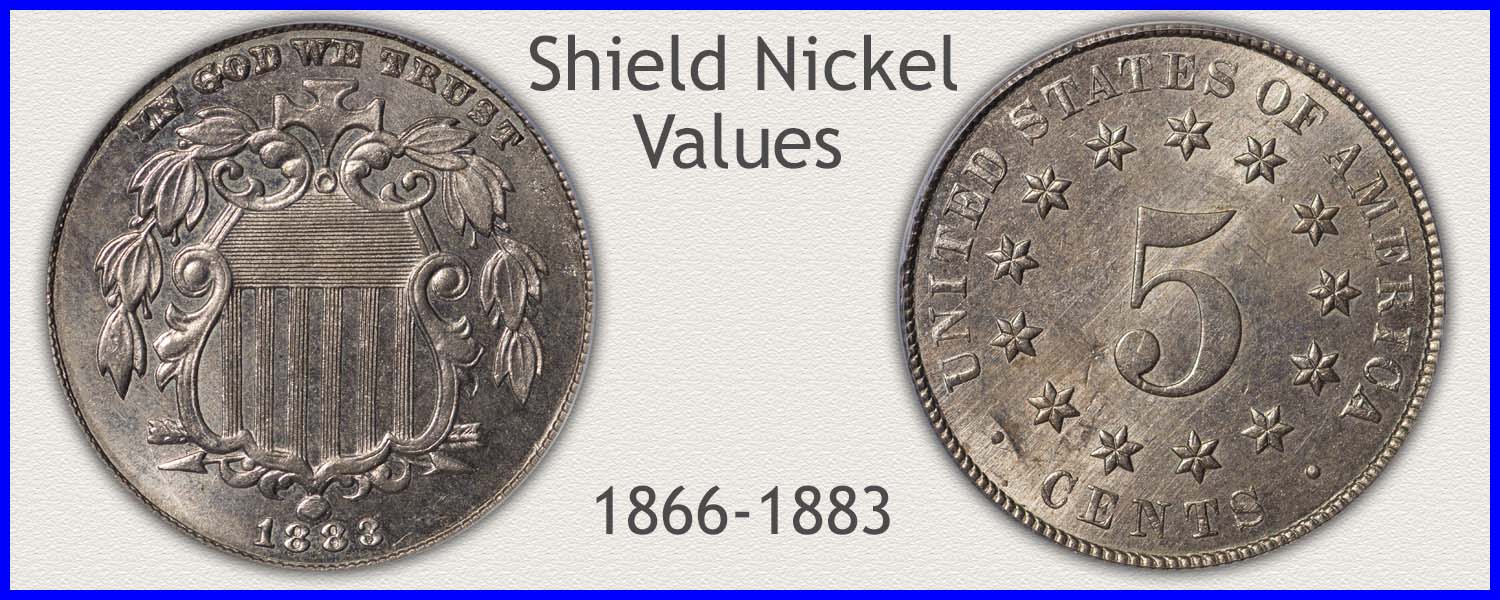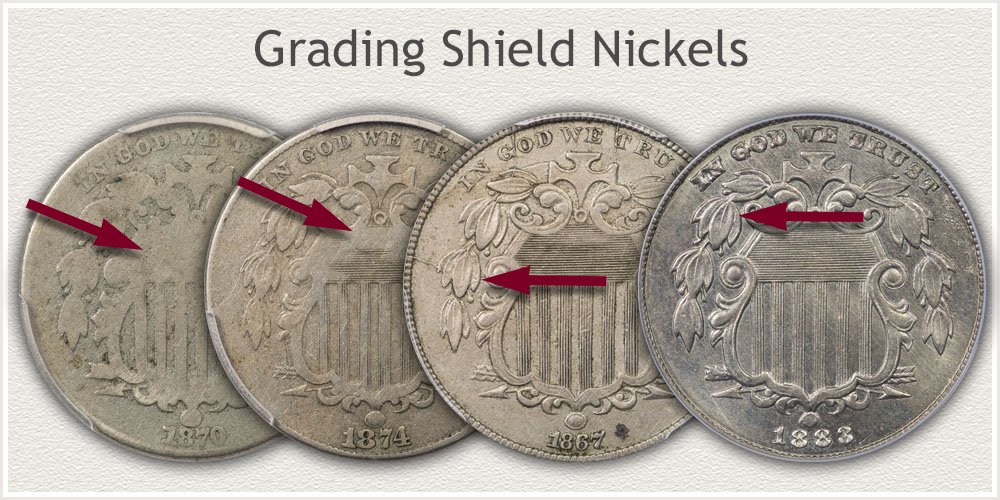Coin Values Moving with Precious Metals: Up-Dated 12/1/2025: Gold $4236 | Silver $56.79
1875 Nickel Value
Using a defined process, and following specific steps, determines 1875 nickel value. First is the basic scarcity of all Shield nickels. This beginning series of the five-cent nickel was never produced in large quantities. Few remain today in nice quality. These nickels were an important denomination in commerce and used extensively.
Follow the steps outlined below. Magnified images point to several key features. These highlighted qualities raise a coin to above average appeal. Interest by collectors and the coin market centers around a coin's date, condition of its surface, and aesthetics. This is a low mintage date, most are now heavily worn, and many have surface problems.
Develop a description of your coin. To see its potential, review the chart listing the range of how much an 1875 nickel is worth.
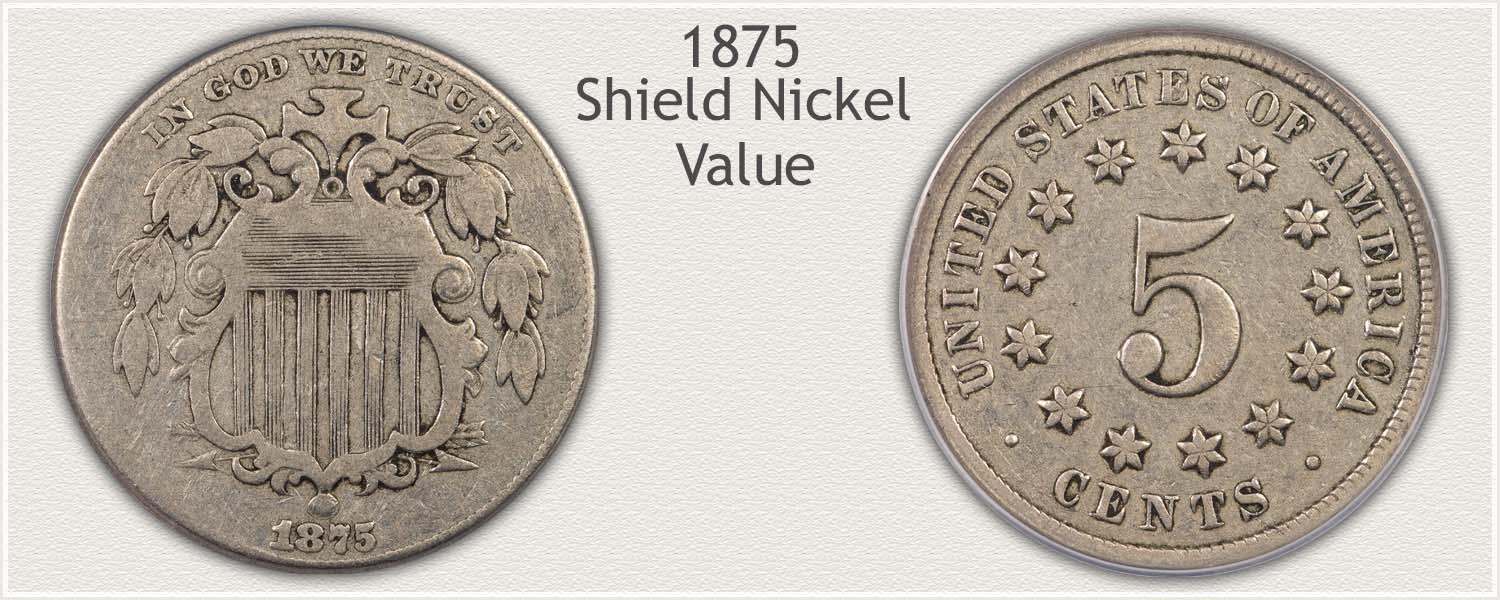
Steps Leading to Value:
- Step 1: Date Identified - All years of the Shield nickel series are popular collectibles. An accurate recording of a coin's date begins to identify its scarcity and demand in the market.
- Step 2: Grading Condition - With condition of the coin as the next key feature. Find a close match comparing your coin to images. Specific quality "grades" narrows the premium range.
- Step 3: Special Qualities - Attempts to "improve" a coin's quality only result in lowering its demand in today's market. Examine subtle indications helping recognize undisturbed quality.
| 1875 Nickel Value | ||||
|---|---|---|---|---|
| Condition of Coin | ||||
| Date | Good | Fine | Extremely Fine |
Mint State |
| 1875 Nickel Value Updated | 2025 | |||
| 1875 | $25 | $68 | $128 | $225 |
Entries in the chart represent wholesale value ranges. A slight difference in a coin's condition contributes to higher or lower premiums. Additionally, market strength and dealer needs determine how much these nickels are worth.
Step 1: 1875 a Date Known for its Scarcity
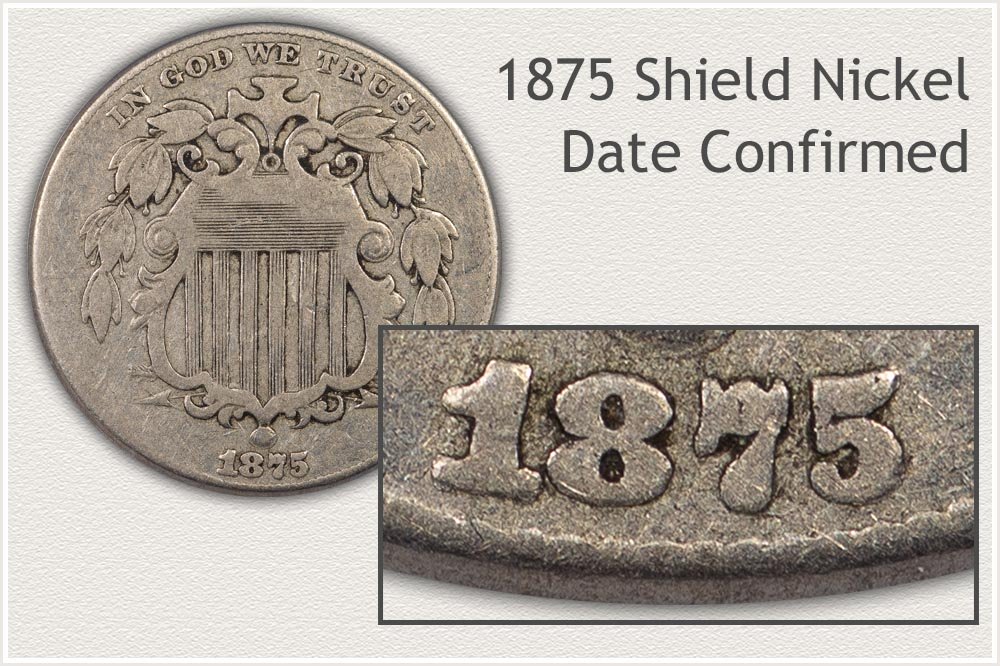
Just over 2 million 1875 nickels entered circulation. At the time, these were heavily used in commerce. Scarce describes the available supply of nice condition examples. Finding a pleasing example is difficult. Premiums for coins in low condition are in line with most years. Although, these are seldom found without problems.
1875 is a year midway through the Shield series. It has become a popular coin with collectors. It combines low mintage, and scarcity of nice condition examples. Demand is strong because values are within the range of many collectors.
To confirm the exact date, magnify the small area below the shield. Vintage style numerals and the small size of the numbers are difficult to identify. Compare your coin to the close-up illustration, helping to recognize the date. Record the date as key information in a full description.
Step 2: | A Comparison Method Identifies Condition and Grade
Grading Recognizes a High Quality 1875 Nickel
Continuing the value process now focuses on the condition of the nickel. Since most 1875 nickels are heavily worn, finding key features determines higher quality. Grading inspects design features to confirm specific elements remain. As example, a Mint State grade coin is without wear on the surface. As a coin circulates, small areas lose their high points, blending into a flat surface. Grading rates the stages of remaining detail and worn areas into grade categories.
By examining the images of various grades, identify the features for each grade. A nickel with many fine lines within the shield grades higher than one with few visible lines. Find an image closely matching your coin. Then focus on the details highlighted in the grade description. This comparison method arrives at a narrow grade range.
Mint State Grade
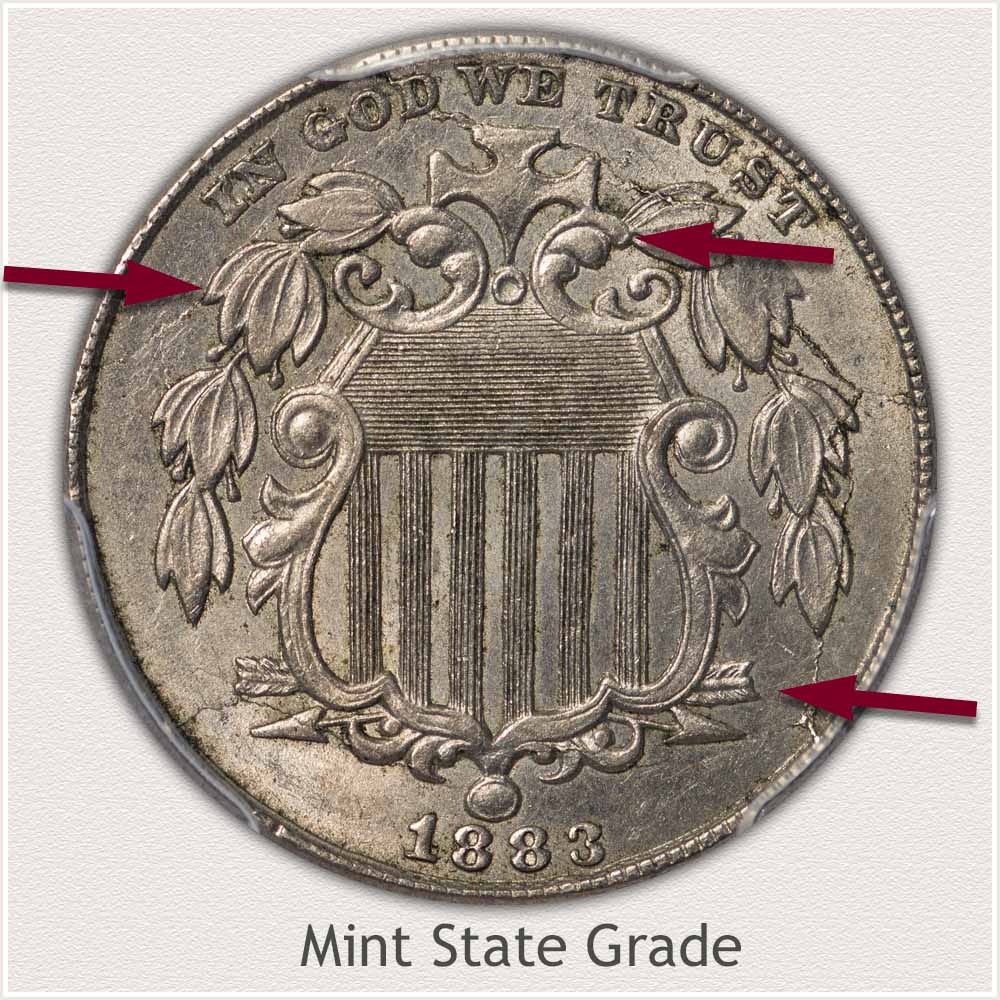
Mint State: Using the comparison method of grading, first inspect the image of a Mint State Shield nickel. Examine your coin, specifically high points, and fine detail, judging for a close match. A surface without wear is the definition of the Mint State grade. Presence of mint luster is a key indicator of an unworn surface. Coins that retain their original luster are candidates for the Mint State grade.
Luster, a coin's brilliance, radiates from the fine texture of unworn metal. This texture is a result of the minting process and covers the entire surface. Disruptions of luster show dullness, and smoothness on the metal. These are the visible signs of initial wear.
An important area to examine are the intricate features of the leaves on the left side of the example coin. Examine the high outer edges, low relief inner areas, and central veins of the leaves. These areas are prone to wear and help judge the level of detail remaining on the coin. Indications of no wear is the edges of the leaves are crisp and well-defined. With no signs of flattening or smoothing, the coin is a candidate for the Mint State condition.
Next, inspect the curved shield decoration located above the horizontal lines. This is another comparison area used when grading condition. Look for crisp edges, the presence of luster, and high contours in the shield decoration. Flattened areas on the tops of contours, along with a dull surface, are signs of wear. Luster on high points of the curved features matching the field below is a good sign the coin is without wear.
A subtle grading feature are the color changes visible on the example image. Areas of the surface are slightly different shades of silver-gray. Other areas show a tan/gold color. The nickel-copper alloy of these coins naturally tones over time, producing the various color. When used by themselves, slight color changes are not reliable indications of wear. A smooth surface lacking the original fine texture needs to confirm wear.
A comparison of the example coin's high and low areas with your coin judges an accurate condition.
Extremely Fine Grade
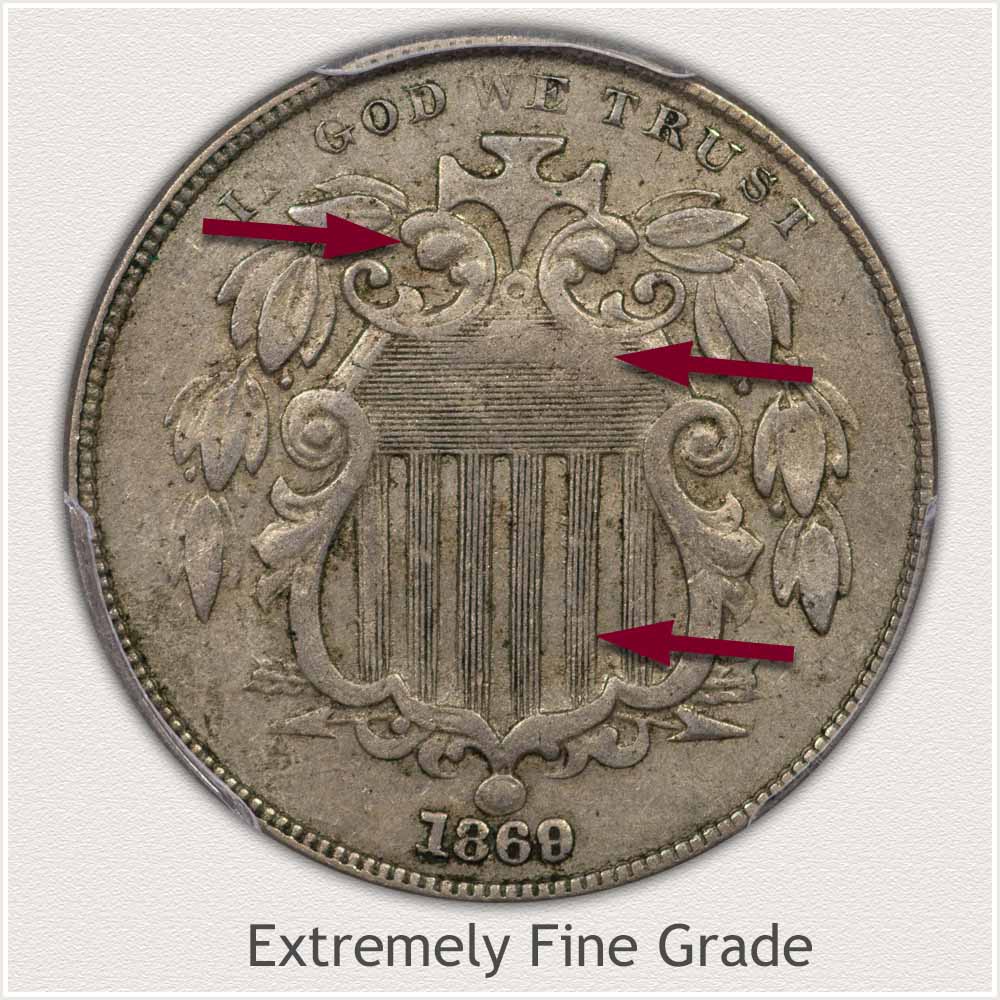
Extremely Fine: An Extremely Fine Grade Shield Nickel shows light wear on its high points. Only small flat areas on the leaves and frame border show signs of wear. This quality coin presents a generally crisp appearance, with most details clearly visible. Grading measures remaining detail on key features when judging the coin's condition. A comparison approach using the image provides the visual requirements for the grade.
Start with the shield, a main focal point of the coin. Condition of the vertical and horizontal lines gauges the coin's condition. Light wear does show on these lines, but most remain distinct and separate.
Wear affects the horizontal different than the vertical lines. Horizontal lines, especially near the top, often merge slightly due to wear. This merging is minor to fit within grade standards. Vertical lines within the shield are typically less worn compared to horizontal lines. Most vertical lines remain deeply separated and crisp. Minor merging, as seen on the example, is minimal.
Next inspect the shield's border. Note, intricate details, scrolls, and raised curved contours, are all visible. At the top of the design, measurable wear flattens high points, just under the cross. However, deep recesses separate these high contoured curved features. This limited amount of wear indicates an Extremely Fine grade coin.
Confirm the condition of your coin with a point-by-point comparison with the image. This professionally graded nickel displays the key requirements. Amount of detail within the shield, levels of wear on the frame, and visible detail of the leaves. Matching to the illustration, judges a narrow grade range.
Fine Grade
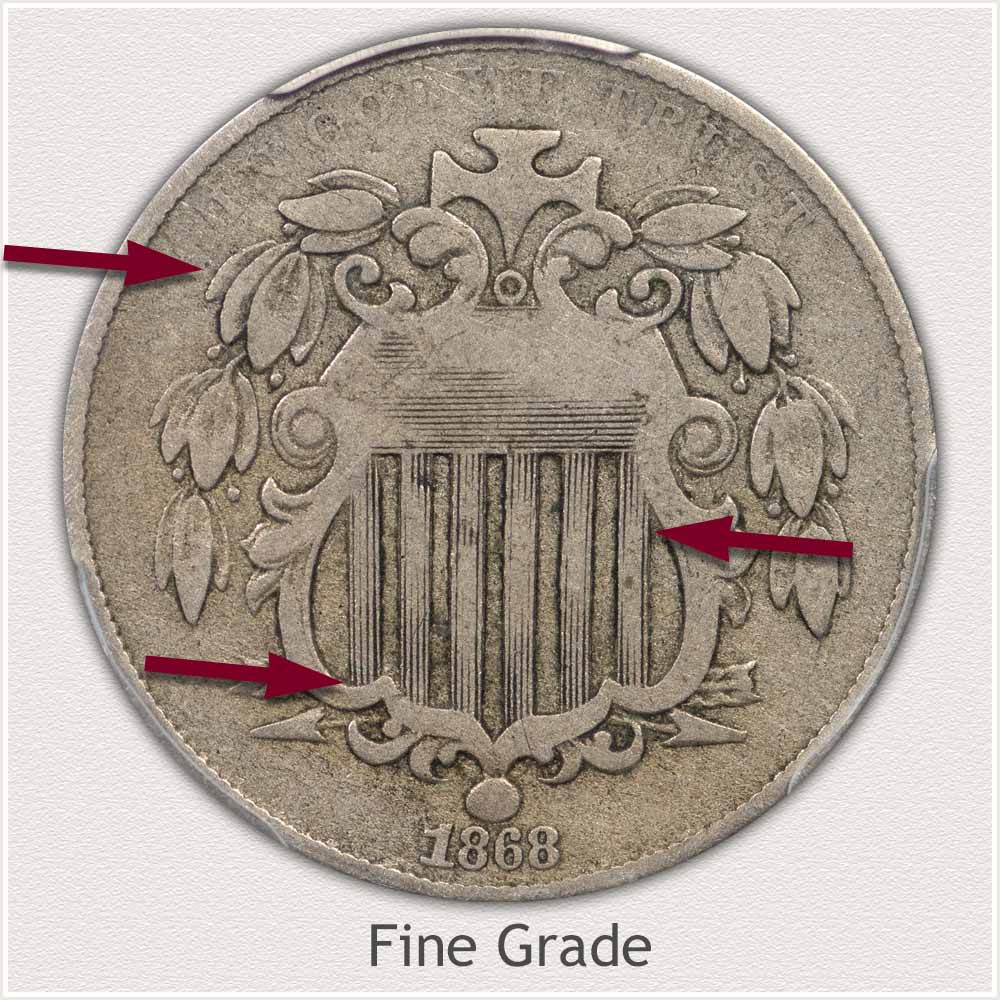
Fine Grade: A moderate amount of wear on the shield describes the condition of Shield nickels in Fine grade. Within the intricate design are many fine details used when measuring wear amounts. A mixture of visible and smooth areas determines the grade.
A highly detailed shield consists of horizontal lines and raised vertical bars. In Fine grade at least half of the horizontal lines are clearly visible.
The raised vertical bars form stripes below the horizontal lines. Deep recesses within the vertical bars create fine lines, enhancing the stripes. Prone to wear, these lines quickly measure wear on their design. Defining the grade, merging of the fine lines is minor and confined to limited areas.
At the base of the vertical stripes, a subtle metric shows on the example image. A strong edge defines and separates the frame from the stripes. This frame edge is slightly higher than the lines within the stripes. A crisp appearance adds visual appeal.
On the sides of the shield, olive branches with leaf clusters show many fine details. Although a few smooth leaves have lost their inner contours. Importantly, most of the edges defining the leaves remain very bold.
A readable motto at the top rim, plus a clear date, finalize the inspection. Overall, most features are well displayed and easily recognizable.
Good Grade
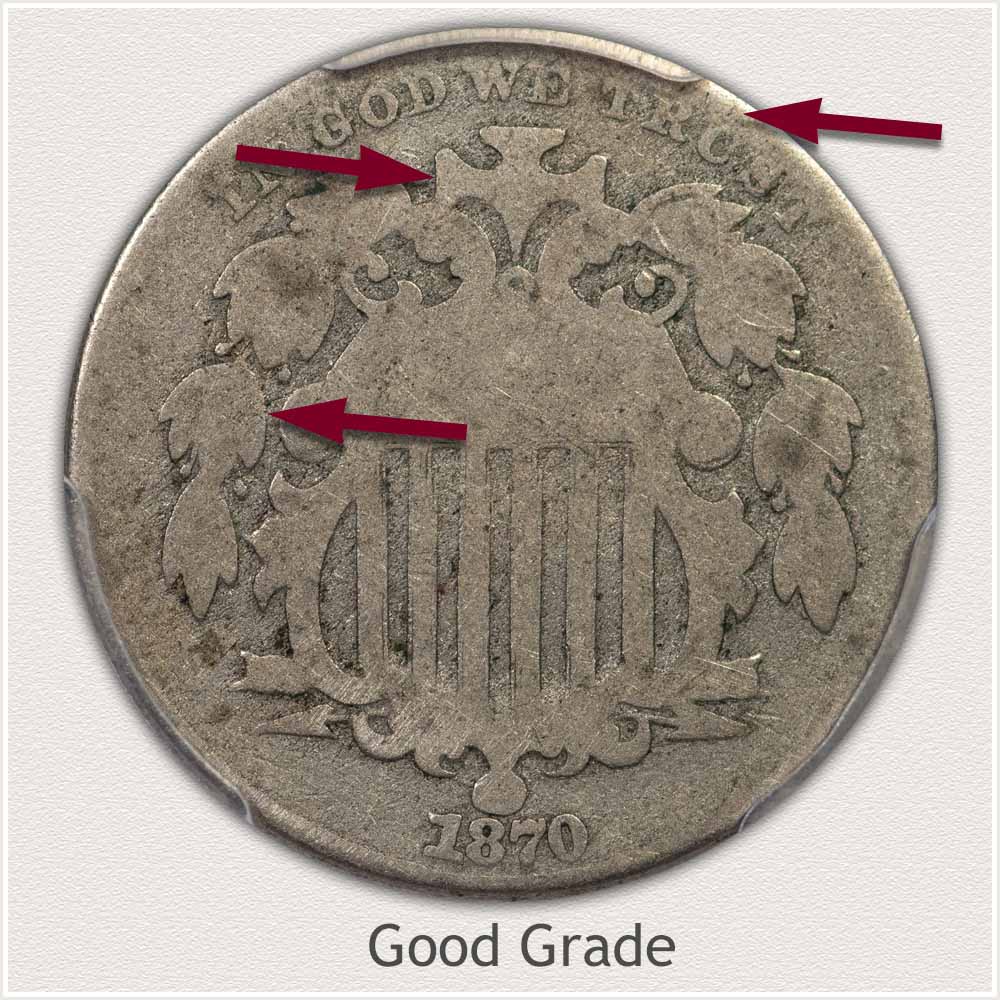
Good Grade: A Shield nickel in "Good" grade displays heavy wear across its entire surface. The example coin was in circulation for an extended period of time. Extensive flattening of the major design features confirms heavy wear. Standard metrics of wear patterns measure and determine its grade.
One key characteristic is within the branches on both sides of the shield. Note all outer edges of the leaf groups remain strong and bold. Heavy wear shows as flat surfaces representing the leaves, with no inner detail. Full outlines surrounding a flat leaf design measures the wear level. The Good grade is an accurate condition judgment.
A second feature indicating the grade is the motto "In God We Trust" above the shield. It remains at least partially visible, with any fading limited to its upper half. Well represented are all lower parts of the letters.
A subtle feature of the Shield nickel is its strike quality. An uneven strike when minted often causes fading towards the outer edges of the nickel. The example displays this weakness in the motto area. Towards the center of the coin, notice this difference in strike with less detail on one side than the other. Judge the stronger side, helping identify true wear. Some fading in areas meets the grade level. Consider the overall condition of the surface as a balancing factor.
A presence of bold outlines on the shield, cross, and leaves gives the coin a pleasing appearance. When the surface is free of deep marks, it is a quality condition, Good grade coin.
How to Video: Grading Shield Nickels
Step 3: | Special Qualities | The Natural Surface Collectible
Originality Stands Out with Eye Appeal
Four coins in the image were carefully chosen to illustrate an original surface. One coin, a fifth, is a coin, cleaned in the past, and now stands out as low quality. Because of its cleaned surface, it does not match the quality displayed by the others.
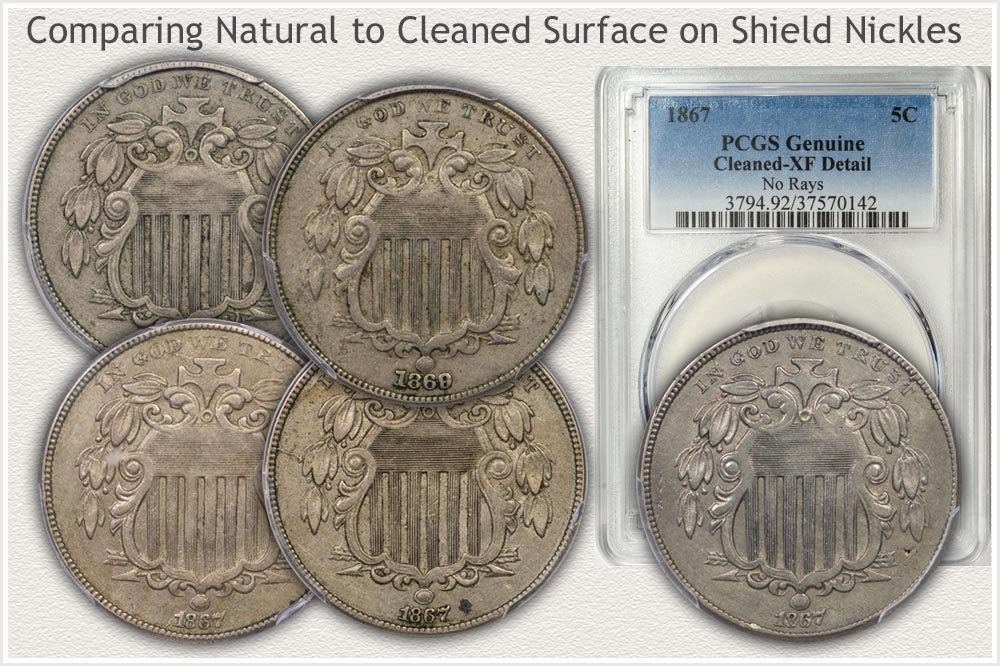 Comparing a Natural to a Cleaned Surface on Shield Nickels
Comparing a Natural to a Cleaned Surface on Shield Nickels
Collectors and dealers both avoid the cleaned coin. Collectors desire original surface quality of the coins in their collections. Dealers also need quality coins in their inventory to provide collectors premium nickels.
Located on the far right is a cleaned coin evaluated by PCGS grading service. Sent to PCGS to grade and encapsulate. They quickly determined the coin was cleaned, noting it on the label. It displays an abnormal tone to its color. When compared with naturally toned coins, it stands with a monotone silver-gray color. This is a color close to stainless dinnerware. Shiny and smooth highlights are visible on smooth surface areas. This is the "Without Rays" variety of the year, in lightly worn condition. Normally a highly sought coin and variety.
Each natural surface coin has a soft texture to its surface and color. The toning lays on the surface, both at high points and in lower relief areas. Colors of gray on the natural coins have varying tones. A light tan mixes into the toning, creating a pleasing, natural, quality surface.
Favored in the coin market, the original surface coins enjoy solid values. Although subtle in overall look, a cleaned coin does stand-out to experienced collectors. Discounted in value are cleaned examples of any condition and date Shield nickel. A special quality nickel is never cleaned.
References
U.S. Mint. Catalogue of Coins of the United States
https://nnp.wustl.edu/library/book/554591
U.S. Mint. 1888 U.S. Mint Annual Report
https://nnp.wustl.edu/library/book/313
Coin Values | CoinStudy Articles
Date by Date
In Depth Shield Nickel Value
Shield Nickel Value | Complete Value Chart of All Years
Complete listing of all Shield Nickel values. 1875 nickels are very scarce and are a value leader on the charts. Because of their age and historical significance, all dates are worth a close look. Separate your coins by condition. Look for above average examples to find a higher value.
How to Grade Shield Nickels | Visual Guide
Referencing the visual guide examines in detail the subtle points of condition. Grading features on both the obverse and reverse are identified, helping determine condition. Additional close-up images plus video point to the details of each grade.
Coin Grading Services | Market Acceptance of Condition
Once a coin enters the scarce category, values follow with high premiums. These coins benefit from professional examinations to establish a market accepted grade. Condition is one of the key elements determining value. Two grading services are leaders in the hobby, PCGS and NGC. Consider using these services when evaluating coins. They help establish a market value.
Selling Coins | A Defined Process
Collectors often sell coins as part of building and improving their collections. Following a process, they first establish values, and judge the strength of the market. Next, they seek dealers specializing in coins like those being sold. First step, organize your holdings. Then review and follow the best practices when selling coins.
Safe Coin Storage | Recommendations
Coin supplies recommended. These are specifically designed for the coin hobby. Each safely hold and preserve coins. A few supplies organize a box of old coins and store them for the long term.
Rare Nickels of the Twentieth Century
All Shield Nickels, are scarce in comparison to later series. Many nickels minted later are scarce because of the date and mint combination. Certain years are seldom found in high quality condition. Still others are a variety containing a precious metal alloy. Identify the rare twentieth century nickels.
★Coin Values Discovery finds 1875 Nickel Value and...
Old U.S. coin values. Referencing images, correctly identify the different coin series, a key first step. Proceed with additional steps, recognizing date and mint combinations. Next, judge the condition of the coin by referencing images. This defined method leads to an accurate evaluation of how much a box of old coins is worth.
